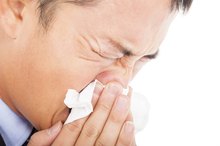Pollen allergies can be caused by trees, grass or weeds. Tiny powdery grains released from flowering plants are carried by the wind when these plants are pollinating. Pollen allows plants to reproduce, but when it is in the air, it can cause irritation of eyes, throat, nose, larynx, trachea and bronchial airways. In the spring, pollinating mesquite trees may cause mild to severe allergic reactions.
If you are experiencing serious medical symptoms, seek emergency treatment immediately.
Pollen from Mesquite Trees
This particular type of tree is the most common small tree in the desert area of the Southwest, from western Texas, to southwestern Utah, southeastern California, Arizona and Mexico. Pollen can travel long distances through the air and levels can be more or less severe throughout the day in the same city or area. Allergic symptoms include hay fever, eye allergies and asthma. Levels of pollen may be highest in early to mid-morning.
- This particular type of tree is the most common small tree in the desert area of the Southwest, from western Texas, to southwestern Utah, southeastern California, Arizona and Mexico.
- Pollen can travel long distances through the air and levels can be more or less severe throughout the day in the same city or area.
Many Uses for Mesquite Trees
Causes of Green Mucus in the Eye
Learn More
Mesquite trees grow below 5,500 feet on the plains and along desert streams and provide many uses 1. Mesquite pods are among the earliest known foods of prehistoric man. Native Americans used the bark to make baskets, fabrics and medicine. The wood can be used for fence posts and tool handles or charcoal scenting for cooking. Mesquite trees are also good firewood and are commonly known as nitrogen-fixing trees, enhancing soil fertility.
- Mesquite trees grow below 5,500 feet on the plains and along desert streams and provide many uses 1.
New Growth May Trigger Allergic Reactions
Mesquites make excellent summer shade trees, losing their leaves and becoming dormant in winter months. Because of the shade provided in summer months, hybrid mesquite trees are commonly used in landscaping in residential neighborhoods. While mesquite trees provide many uses to society, it is one of the top pollen-producing trees in the western United States. Seasonal allergies may be triggered when these trees are experiencing new growth between February and June each year.
- Mesquites make excellent summer shade trees, losing their leaves and becoming dormant in winter months.
- Because of the shade provided in summer months, hybrid mesquite trees are commonly used in landscaping in residential neighborhoods.
Variety of Allergy Relief
Seasonal Allergy Symptoms - Chest Tightness & Pain
Learn More
Allergy sufferers may require medications typically used for mold and other allergies, such as antihistamines and bronchia dilators. Other symptom relievers include injections, through which the patient is given gradually increasing dosages of the allergens until they develop a tolerance to that allergen. A newer method of treatment, called energy-based allergy elimination, is purported to permanently eliminate allergies to pollen and other allergens that cause hay fever symptoms.
Vitimins and Herbs May Minimize Allergy Symptoms
Natural allergy treatment methods are becoming popular because they strengthen the immune system, minimize allergy symptoms and provide relief for the annoying symptoms of hay fever such as sneezing, runny nose and eye irritation. Some nutrients work as natural antihistamines and decongestants to keep breathing passages clear. Still other herbs and dietary supplements relieve the inflammation often caused by allergies. Vitamin C is often recommended as a natural allergy remedy and a highly effective antioxidant.
- Natural allergy treatment methods are becoming popular because they strengthen the immune system, minimize allergy symptoms and provide relief for the annoying symptoms of hay fever such as sneezing, runny nose and eye irritation.
- Some nutrients work as natural antihistamines and decongestants to keep breathing passages clear.
Related Articles
References
- Desert USA: The Mesquite, Something that Belongs
- Asthma and Allergy Foundation of America. Pollen Allergies.
- Dellavalle CT, Triche EW, Leaderer BP, Bell ML. Effects of ambient pollen concentrations on frequency and severity of asthma symptoms among asthmatic children. Epidemiology. 2012;23(1):55-63. doi:10.1097/EDE.0b013e31823b66b8
- Handa S, De D, Mahajan R. Airborne contact dermatitis - current perspectives in etiopathogenesis and management. Indian J Dermatol. 2011;56(6):700-6. doi:10.4103/0019-5154.91832
- Texas MedClinic. Symptoms and Remedies for Cedar Fever.
- Portelli MA, Hodge E, Sayers I. Genetic risk factors for the development of allergic disease identified by genome-wide association. Clin Exp Allergy. 2015;45(1):21-31. doi:10.1111/cea.12327
- The American Academy of Allergy, Asthma & Immunology. SLIT Treatment for Allergic Rhinitis Nothing to Sneeze About.
- Oral allergy syndrome (OAS). The American Academy of Allergy, Asthma & Immunology.
- Gao Z, Huang M, Qu Z, Wang J, Cai X.Identification of DNA methylation module in seasonal allergic rhinitis.Int J Pediatr Otorhinolaryngol. 2019 Feb;117:163-166. doi: 10.1016/j.ijporl.2018.11.030. Epub 2018 Nov 29.
- Maya-Manzano JM, Sadyś M, Tormo-Molina R, Fernández-Rodríguez S, Oteros J, Silva-Palacios I, Gonzalo-Garijo A.Relationships between airborne pollen grains, wind direction and land cover using GIS and circular statistics.Sci Total Environ. 2017 Apr 15;584-585:603-613. doi: 10.1016/j.scitotenv.2017.01.085. Epub 2017 Jan 27.
Writer Bio
Working from her home office, Susannah Michaels enjoys researching, compiling information and writing on just about any subject. Her interests are as varied as her work, which includes writing for “Reno-Tahoe Area Guide” and editing for “The World Ahead.” In Dallas she worked for IBM and others as a technical writer. Michaels holds a bachelor's degree in music/English from University of North Texas.








